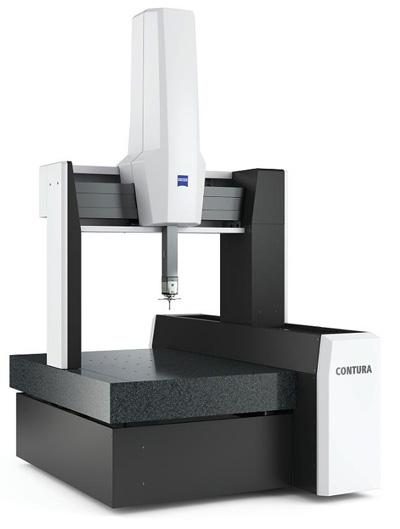
The latest generation of the successful ZEISS CONTURA coordinate measuring machine is entering the market. This system provides a platform for flexible, reliable and uncompromising quality assurance, according to the company. It is even more precise than its predecessor and offers a large package of optical sensors on top of additional measuring ranges. Outstanding scanning technology, ZEISS CALYPSO reference software and a highly tuned overall system enable ZEISS CONTURA to maintain its place as the standard in its class.
Like no other ZEISS coordinate measuring machine, ZEISS CONTURA has made high-performance measuring technology available to the masses. The latest generation will continue on this proven path. A reliable measuring system is the result of the interaction of its components: design, sensors, software and service. "With ZEISS CONTURA, customers receive a well-balanced system and thus a guarantee for stable, reproducible precision. Put simply: results you can rely on," says Andrzej Grzesiak from ZEISS Industrial Metrology business group. Thanks to its robust design, ZEISS CONTURA can also be used near production. The latest and most powerful scanning sensors from ZEISS are available for the machine.
In tune with the various customer requirements, sensors are available in the direkt, RDS and aktiv versions. With the ZEISS VAST XXT probe, the direkt model enables scanning. This configuration is ideal for small workpieces, for which a small single or star stylus is sufficient. Scanning makes it possible to efficiently and precisely measure the form in addition to the size and location. For parts with different angular positions, the RDS sensor model is the right choice. The RDS articulating probe holder can be freely positioned in 2.5 degree increments, resulting in more than 20,000 possible positions. Thanks to the RDS-CAA, the data from every single position can be mathematically calculated in just a few minutes. "This drastically improves the utilization level of the machine and results in additional possibilities to immediately measure even complex angular positions," states Grzesiak. Its sensor interface permits the flexible use of contact and optical sensors, including the new ZEISS LineScan sensor. It enables the fast optical measurement of features.
The aktiv configuration is recommended when long styli are needed for measurements deep inside a part or for additional demands on precision and speed. The ZEISS VAST XTR gold and VAST XT gold premium probes are available. This active regulation enables highly accurate measurements with very long, heavy stylus systems. "Active scanning is a unique value added by ZEISS," emphasizes Grzesiak. navigator technology from ZEISS, which enables a tangential approach without a stop and go, as well as circular or helical scanning, results in added productivity.
Another new feature is the range of measuring volumes. The ZEISS CONTURA family has eight different sizes starting with a measuring volume of 700 x 700 x 600mm up to 1200 x 2400 x 1000 millimeters. From a design standpoint, ZEISS CONTURA is based on proven features: its efficient, highly precise air bearings are an in-house development. ZEISS AirSaver can also be integrated for additional savings. This technology reduces compressed air consumption by up to 60 percent depending on how it is used.
Contact Details
Related Glossary Terms
- metrology
metrology
Science of measurement; the principles on which precision machining, quality control and inspection are based. See precision machining, measurement.
- quality assurance ( quality control)
quality assurance ( quality control)
Terms denoting a formal program for monitoring product quality. The denotations are the same, but QC typically connotes a more traditional postmachining inspection system, while QA implies a more comprehensive approach, with emphasis on “total quality,” broad quality principles, statistical process control and other statistical methods.

